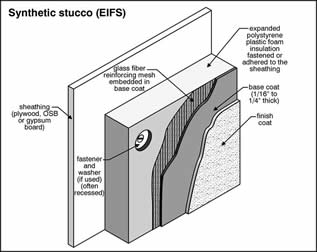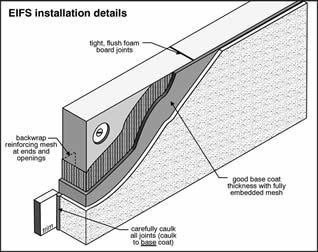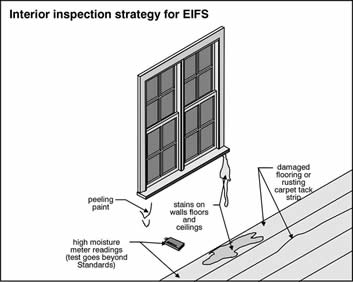|
With Urea Formaldehyde Foam Insulation, most of us pronounce it "you-fee" but some insisted on "u-fee." "E-fiss" appears to be the preferred pronunciation for EIFS.
So now we can say it, but what is EIFS and why do we care? EIFS stands for Exterior Insulating and Finishing Systems. It is sometimes referred to as Synthetic Stucco. Its use increased sharply in the 1990s. In North America about 300,000 homes have an EIFS exterior.
We care because EIFS has been connected to concealed rot in wall cavities.
 
A LITTLE HISTORY
In 1994, moisture damage to the interior of walls was being linked to EIFS. In August 1995, 32 EIFS clad homes in North Carolina were tested and 30 were found to have moisture problems. In January 1996, the National Association of Home Builders issued a "Builders Alert" about EIFS. In May 1996, Raleigh North Carolina imposed a moratorium on the product through January 1997. In March 1996, the North Carolina Building Code Council adopted stringent guidelines for the application of EIFS mandating that a drainage system be installed in the exterior walls of EIFS homes. By September 1996, twelve class-action law suits had been launched in the United States. In September 1996, Maryland Casualty Company notified its clients, who were contractors, that work with EIFS systems would no longer be insurable. At about the same time, a major relocation company advised its clients that it would eliminate the guarantee on EIFS homes for employees seeking their services during a transfer.
The Mortgage Division of the Chevy Chase Bank decided about the same time to no longer accept mortgages on houses built with Synthetic Stucco. In January 1997, the Georgia Association of Realtors changed its property disclosure statement to disclose whether the house was built with EIFS.
WHAT EXACTLY IS IT?
There are many different systems offered by various manufacturers, but in general EIFS wall systems consist of a wood frame wall covered with sheathing such as plywood, or even gypsum board. Plastic foam insulation boards are glued or fastened to the sheathing. A 1/16- to 1/4-inch-thick base coat is troweled on to the insulation. A glass fiber reinforcing mesh is embedded in the base coat. Finally, a finished coat is sprayed, toweled or rolled on. This finish coat provides the color and texture.
Many installations have no building paper or house wrap behind the stucco to act as a backup material.
WHAT IS HAPPENING?
Rain water appears to be getting into the wall systems through imperfections in the stucco. These include joints around windows and doors and penetrations from railings, wiring, plumbing, vents, etc. Once water gets behind the system it gets trapped, leading to mold, mildew and rot of the sheathing, studs, flooring and other framing members. EIFS houses often look good until sections of the wall are removed revealing concealed damage. The damage can take place within the first few years of the home's life.
As most of the damage has been found in houses in coastal areas, some have suggested that condensation is a problem; however, since the most severe damage seems to show up around wall penetrations, condensation does not appear to be the culprit. The worst damage is often found below and beside windows.
 
SOLUTIONS
There is little that can be done on existing systems short of re-siding or paying fanatical attention to keeping the water out. Caulking and flashing maintenance should be a high priority for people with synthetic stucco houses.
In the very newest installations, contractors are using building paper or house wrap behind the insulation to protect the sheathing. In addition, the newest installations are designed with a drainage system behind the insulation to allow any water which does get in, to drain out. This is not unlike the drainage system found in a brick veneer home. These improvements should work but only if they are well constructed.
CONCLUSIONS
So far we know that areas of high rain fall, and particularly areas with rain accompanied by wind, result in houses with the most damage. Homes which have no roof overhang or very small overhang or many penetrations through the wall systems are also at risk.
Unfortunately, a visual inspection cannot tell the whole story, and until invasive testing becomes standardized and sufficient data becomes available for our area, concealed damage in synthetic stucco houses will remain a question mark.
Illustrations are from the Carson Dunlop Illustrated Home.
<< Back to Technical Library |